Urban Heat Island Effect
e) How Can Urban Heat Island be Remediated
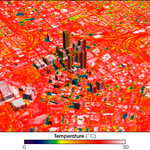
Several communities have already piloted new methods for combating UHI. The most common types of remediation are increasing vegetation cover, creating “green roofs” which utilize vegetation, installing cool roofs which commonly use reflective surfaces, and lastly, using cool pavements which reduce heat absorption.
Trees and Vegetation
Trees and vegetation are a natural mitigation method that helps cool the environment. Urban heat islands are created when the natural landscape is removed and replaced with impervious surfaces. By reintroducing vegetation into the cityscape can help lower the surface and air temperature by providing shade and through evapotranspiration (USEPA, 2011). Evapotranspiration can be defined as the sum of evaporation and plant transpiration. Evaporation is the movement of water to the air from surfaces like soil and water, while plant transpiration is the movement of water within plants and the loss of water vapor through the plant’s leaves (Wikimedia, 2011). Evapotranspiration can help reduce peak summer temperature by 2-9°F, while shaded surfaces can be 20-45°F cooler than unshaded surfaces (Huang, et al., 1990).
The reintroduction of vegetation is the most basic mitigation method, and can be used in conjunction with other methods. The benefits of vegetation include reduced energy use, improved air quality, reduced greenhouse gas emissions, enhanced water quality, reduced pavement maintenance and improved cityscape aesthetics. Although trees and vegetation are an excellent mitigation option, they can be costly depending on the type of vegetation, initial planting and the long term maintenance.
“Green Roofs”
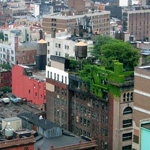 Green roof mitigation is similar to the reintroduction of vegetation. However green roofs, also referred to as a rooftop gardens, use a layer of vegetation specifically on rooftops. By replacing a typical rooftop with a vegetative layer helps reduce the temperature on the roof surface and the surrounding air through shade and evapotranspiration (USEPA, 2011). Reducing the surface temperature of the rooftop ultimately reduces the temperature of the building, which reduces the energy consumption used for air conditioning. On a hot summer day, the surface temperature of a green roof can be cooler than the air temperature, whereas a conventional rooftop can be up to 90°F warmer (Liu and Baskaran, 2003).
Green roof mitigation is similar to the reintroduction of vegetation. However green roofs, also referred to as a rooftop gardens, use a layer of vegetation specifically on rooftops. By replacing a typical rooftop with a vegetative layer helps reduce the temperature on the roof surface and the surrounding air through shade and evapotranspiration (USEPA, 2011). Reducing the surface temperature of the rooftop ultimately reduces the temperature of the building, which reduces the energy consumption used for air conditioning. On a hot summer day, the surface temperature of a green roof can be cooler than the air temperature, whereas a conventional rooftop can be up to 90°F warmer (Liu and Baskaran, 2003).
Green roofs are very versatile. They can be installed on industrial buildings, commercial skyscrapers or even private homes. Typically green roofs use shallow root vegetation like grass or shrubbery. However in some cases they can be a fully landscaped park. Similar to vegetation mitigation, the benefits of green roofs are reduced energy use, reduced air pollution and greenhouse gas emissions, enhanced storm water and runoff water quality, and improved aesthetic value. Other benefits include improved human health and comfort. For an apartment building or private home, green roofs reduce heat transfer though the roof which improves indoor comfort and lowers heat stress (USEPA, 2011).
The primary disadvantage of a green roof is the initial and maintenance cost. Installation, materials and long term maintenance can be expensive depending on the roofing system. Another disadvantage is limitations in retrofitting an existing building with a new green roof. In older cities, like New York or Chicago, green roofs may not be a viable option, because older buildings are not designed to withstand that type of dead load. Although the initial cost for a green roof is higher than a conventional roofing system, the long term benefits may balance the cost. Green roofs reduce building energy consumption, reduce stormwater management costs, and can potentially have a longer lifespan than conventional roofing material (USEPA, 2011).
Cool Roofs
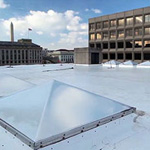 Rooftops are the second most abundant surface found in metropolitan areas. Common urban roofing materials include metal shakes or shingles, asphalt shingles, concrete and metal roofing. All of these materials are impervious and have varying degrees of solar reflectance, also known as albedo. Albedo is the most important characteristic of a cool roof, because it is the measurement of how much solar radiation is reflected away from the building, ultimately reducing the roof temperature (Figure 3)(USEPA, 2011). The thermal emittance is another important material property of roofing material. Emittance can be defined as the material’s ability to release absorbed heat (USEPA, 2011). In combination these two properties help roofs absorb less heat and allowing 50-60°F cooler temperatures than conventional materials (Konopacki, et al., 1998).
Rooftops are the second most abundant surface found in metropolitan areas. Common urban roofing materials include metal shakes or shingles, asphalt shingles, concrete and metal roofing. All of these materials are impervious and have varying degrees of solar reflectance, also known as albedo. Albedo is the most important characteristic of a cool roof, because it is the measurement of how much solar radiation is reflected away from the building, ultimately reducing the roof temperature (Figure 3)(USEPA, 2011). The thermal emittance is another important material property of roofing material. Emittance can be defined as the material’s ability to release absorbed heat (USEPA, 2011). In combination these two properties help roofs absorb less heat and allowing 50-60°F cooler temperatures than conventional materials (Konopacki, et al., 1998).
Cool roofing materials have been used for more than 20 years on a variety of buildings, including commercial, industrial and residential buildings. Aside from the economic and environmental benefits, government programs have been developed to help consumers be more “energy friendly.” Programs like ENERGY STAR which were developed though the Environmental Protection Agency (EPA) and the Department of Energy (DOE), help consumers identify the most energy efficient roofing products (USEPA, 2011).
Aside from the obvious benefits like reduced energy uses, cool roofs also help reduce air pollution and greenhouse gas emission and can improve human health and comfort. Unlike green roofs, cool roofs are more affordable, however they are often more expensive than conventional roofing materials. The additional cost of cool roofing material is typically offset by energy saving.
A common cool roofing material is white vinyl, which has the highest reflective and emittance capacity for cool roofing. Another common cool roof material is reflective coating. A reflective coating can be applied to new or existing roof, which can drastically improve the solar-reflectance of the material.
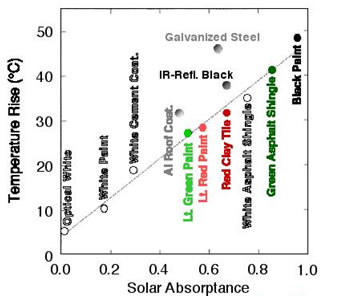 Figure 3. (Chang, 2000)
Figure 3. (Chang, 2000)
Cool Pavements
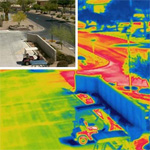 Concrete, asphalt and pavement are the most abundant surface in metropolitan areas, covering 35-40% of the cityscape (Akbari, et al., 1999). These impervious surfaces have low solar reflectance and emittance, which is a major cause of UHI. By reducing or replacing these impervious surfaces with “cool pavements” there is potential for a dramatic effect on UHIs. Cool pavements can be defined as paving materials that reflect more solar energy, enhance water evaporation, and/or have been modified to remain cooler than conventional pavement (USEPA, 2011).
Concrete, asphalt and pavement are the most abundant surface in metropolitan areas, covering 35-40% of the cityscape (Akbari, et al., 1999). These impervious surfaces have low solar reflectance and emittance, which is a major cause of UHI. By reducing or replacing these impervious surfaces with “cool pavements” there is potential for a dramatic effect on UHIs. Cool pavements can be defined as paving materials that reflect more solar energy, enhance water evaporation, and/or have been modified to remain cooler than conventional pavement (USEPA, 2011).
Conventional paving materials can reach a surface temperature of 120-150°F (USEPA, 2011). This super heated surface not only affects the surrounding air temperature but can have detrimental effects on stormwater runoff. Cool pavements are one mitigation approach to help reduce the effect of UHI. Cool pavement technology is not a new technology. Typically cool pavements are created using existing paving methods, combined with new ideas like reflective coating or permeable pavers. There are several different types of cool paving materials including pervious pavers, pervious/porous pavement and green pavers. The benefits of cool pavements are reduced storm water runoff, improved runoff water quality, lower tire noise, enhanced roadway safety, increased nighttime visibility and improved local comfort. Comparing the cost of conventional paving to cool paving materials is difficult because cost can vary based on region, contractor, materials, accessibility to site, availability of materials, project size and the design life of the pavement (USEPA, 2011).
Section a) Introduction (HOME)
Section b) Why is Urban Heat Island a concern?
Section c) How Climate Change will affect UHI
Section d) Measuring the Urban Heat Island Effect
Section e) How can Urban Heat Island be Remediated?
Section f) Mitigation at Local/Regional/National Level (NEXT)
(By Kiersten Lee/Gregory Möller)

